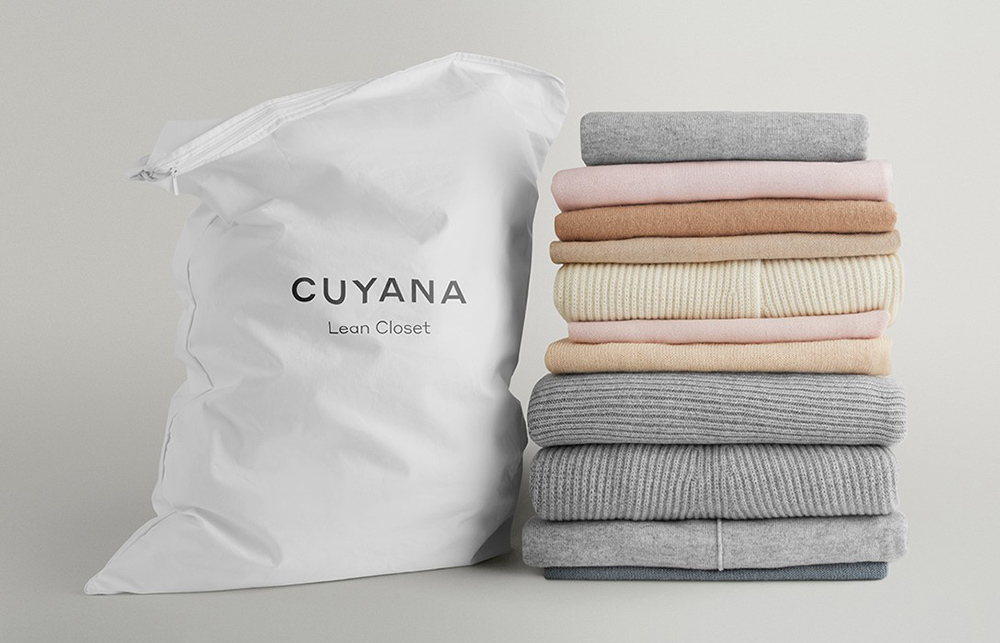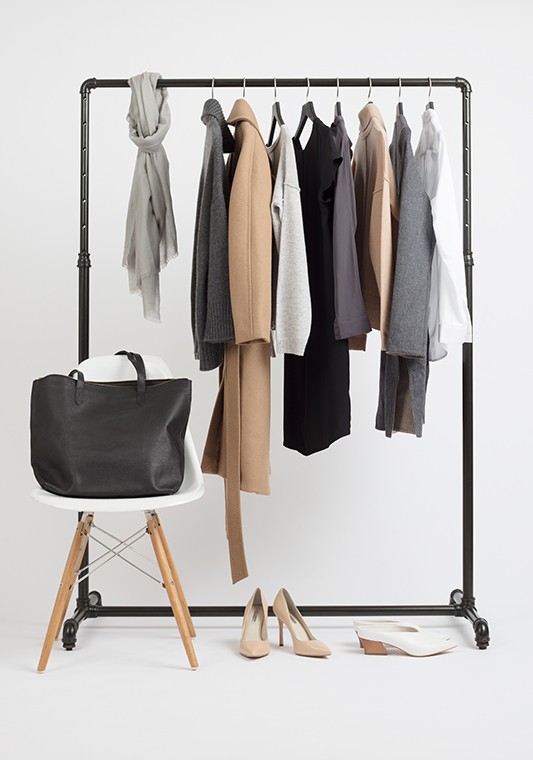
时尚行业华丽服装的背后,是巨大的资源浪费,受经济放缓影响,现在各大品牌又都在想方设法处理滞销产品,这让“时尚浪费”问题比以往任何时候都倍受关注。
时尚品牌Cuyana认为,就最大程度减少浪费而言,自己在时尚行业已经遥遥领先。这家位于旧金山的企业表示,公司只生产零售商认为可以售出的产品,也由此实现了90%的售罄率,这在时尚行业绝对是令人羡慕的成绩。而傲人的成绩同样离不开Cuyana选材精良、功能多样且四季皆宜(可能是其最重要的卖点)的产品,即便出现供应过剩,产品也很容易放到下一季度甚至下一年度继续销售,从而获得更长的销售时间。
相较于竞争品牌,Cuyana的服装所选面料都十分结实耐用,其中尤以仅出产于秘鲁北部的比马棉织物最为出色,这种耐用性也是Cuyana最为人称道的特质之一。据估计,比马棉面料的使用寿命较标准棉面料长50%。为了在裙子、衬衫、裤子以及更多服装产品中应用比马棉材料,并让顾客在日常生活中以这些产品为基础穿搭出各种不同风格,Cuyana投入可谓不菲。
正是基于这些思考,Cuyana推出了“100天、2件衣服、50套穿搭”的挑战赛,让顾客用两件比马棉服饰在100天内传出各种不同风格。
近期,《财富》杂志采访了Cuyana的联合创始人卡拉·加利亚多和希尔帕·沙阿,讨论了她们在疫情期间消除时尚浪费的策略。
为简明期间,以下采访内容做了一些编辑。

《财富》:早在新冠疫情爆发前,快时尚及其造成的浪费就已经成为零售业和环境保护者头疼的大问题。过去几年,Cuyana的服饰产品在市场上赢得了“中端价格、更高品质”的美誉。在“减少时尚浪费”方面,你们交出比同行更好的成绩单,这是怎么做到的?
沙阿:Cuyana的经营理念是“更少就是更好”,即购买经久耐用、功能多样的产品,延长使用寿命,减少浪费。与大多数品牌不同,我们希望顾客买少一点、买好一点,而不是鼓励顾客买太多衣服。此外,我们除了生产和销售,还会通过构思一些新的穿搭来吸引顾客尽可能穿上我们的衣服,我们也会为顾客提供护理指导,教会顾客通过精心保养来延长产品的使用寿命。
考虑到Cuyana是时尚行业的服装零售品牌,从商业角度来看,你们鼓励消费者少买衣服的做法会不会有点“反常”?是什么促使你们发起了“100天、2件衣服、50套穿搭”的活动?
加利亚多:发起这一活动是为了推广Cuyana主打的比马棉纤维材料,展示其品质、多用性及超长的使用寿命。我们会向客户提供各种信息和建议来激发他们的灵感,使得他们能在100天内用2件比马棉衣服穿搭出各种不同风格。之所以会发起这项挑战赛,是因为我们了解到每位消费者平均每年会购买68件衣服,而这些衣服平均只穿7次就会被丢掉。(浪费如此严重),难怪大家会把时尚视为气候变化的罪魁祸首之一。
当然,我们还发现,消费者一旦购买Cuyana品牌的服饰,感受过我们产品的品质和强大功能,就会慢慢用我们的服饰来打造自己的衣橱,并有可能成为我们的忠实粉丝。通过持续提供经久耐穿的高品质服饰,我们与顾客建立了良好的关系,也成为了他们购买必备衣物的首选,对我们而言,这里蕴藏着巨大的商机。赢得消费者的信任,从而在必备衣物市场获得一席之地是我们的经营目标,而要想实现这一目标,我们就必须不忘初心,不断设计出耐用的高品质产品。
许多零售商在这次经济下行中遭受了重大打击。与此同时,消费者可能也在重新审视自己的购物习惯,从购买更多便宜产品转向购买高价值产品。疫情对Cuyana有何影响?
加利亚多:与许多零售商(尤其是那些已经关闭实体店的零售商)一样,Cuyana的销售额也经历了从下滑到缓慢稳定恢复的过程。不过,我们也发现,在Cuyana拥有很强优势的基础产品方面,销售情况却是一如既往的好。现在,消费者比以往任何时候都更愿意购买舒适,品质又好的日常必备衣物。
此外,我们在设计产品时就已将产品的适应性纳入考量,希望为消费者提供能够随着生活场景、生活方式变化而改变的产品。我们以创新的方式将产品的审美功能和实用功能完美地结合在一起。比如,我们有一款“三合一”包包,可以用作手抓包、钱包和腰包使用,我们的背包也配有一根可拆卸的背带,可以作单肩包使用。这种多功能性就体现了我们所说的“更少就是更好”理念:提供结实耐用、功能多样的产品。

展望未来,疫情过后,零售商可以采取哪些措施来远离快时尚、增加对(产品)重复使用、回收利用的投入?
沙阿:我们认为,这次疫情和随之而来的“慢生活”为我们打造更可持续的生活方式创造了可能。品牌方超购存货造成浪费是快时尚行业的大问题。为了抓住每个可能的销售机会,许多品牌都愿意超购相对便宜的存货。当打折也无法卖掉这些存货时,他们就会干脆把这些存货扔掉或者烧掉。让我们感到震惊的是,60%的成衣会在出厂一年之内会被烧掉或者丢进垃圾堆填区。
我们没有采用这种模式,而是尽可能地根据需求来确定采购量,从而避免出现生产过剩的情况,即便这意味着限量版产品会被迅速抢购一空。我们专注于提供四季皆宜的核心款服饰,所以大部分产品都可以全年销售,不需要退出(扔掉)过季未售出的产品。
最后,我们一直与暴力干预计划(Violence Intervention Program)的分支机构H.E.A.R.T.(Helping Ease Abuse Related Trauma,帮助减轻虐待相关创伤组织)保持着合作关系,并通过该组织将我们的滞销产品捐赠给那些有需要的女性。2019年,我们售出了90%的产品,相对于60%到70%的行业标准来说,这个数字可以说是非常高了。我们希望每个零售商都能认真对待这个指标,并通过适当方法来减少库存积压,或者通过捐赠、回收等更可持续的方式让产品退出市场。(财富中文网)
译者:Feb
时尚行业华丽服装的背后,是巨大的资源浪费,受经济放缓影响,现在各大品牌又都在想方设法处理滞销产品,这让“时尚浪费”问题比以往任何时候都倍受关注。
时尚品牌Cuyana认为,就最大程度减少浪费而言,自己在时尚行业已经遥遥领先。这家位于旧金山的企业表示,公司只生产零售商认为可以售出的产品,也由此实现了90%的售罄率,这在时尚行业绝对是令人羡慕的成绩。而傲人的成绩同样离不开Cuyana选材精良、功能多样且四季皆宜(可能是其最重要的卖点)的产品,即便出现供应过剩,产品也很容易放到下一季度甚至下一年度继续销售,从而获得更长的销售时间。
相较于竞争品牌,Cuyana的服装所选面料都十分结实耐用,其中尤以仅出产于秘鲁北部的比马棉织物最为出色,这种耐用性也是Cuyana最为人称道的特质之一。据估计,比马棉面料的使用寿命较标准棉面料长50%。为了在裙子、衬衫、裤子以及更多服装产品中应用比马棉材料,并让顾客在日常生活中以这些产品为基础穿搭出各种不同风格,Cuyana投入可谓不菲。
正是基于这些思考,Cuyana推出了“100天、2件衣服、50套穿搭”的挑战赛,让顾客用两件比马棉服饰在100天内传出各种不同风格。
近期,《财富》杂志采访了Cuyana的联合创始人卡拉·加利亚多和希尔帕·沙阿,讨论了她们在疫情期间消除时尚浪费的策略。
为简明期间,以下采访内容做了一些编辑。
《财富》:早在新冠疫情爆发前,快时尚及其造成的浪费就已经成为零售业和环境保护者头疼的大问题。过去几年,Cuyana的服饰产品在市场上赢得了“中端价格、更高品质”的美誉。在“减少时尚浪费”方面,你们交出比同行更好的成绩单,这是怎么做到的?
沙阿:Cuyana的经营理念是“更少就是更好”,即购买经久耐用、功能多样的产品,延长使用寿命,减少浪费。与大多数品牌不同,我们希望顾客买少一点、买好一点,而不是鼓励顾客买太多衣服。此外,我们除了生产和销售,还会通过构思一些新的穿搭来吸引顾客尽可能穿上我们的衣服,我们也会为顾客提供护理指导,教会顾客通过精心保养来延长产品的使用寿命。
考虑到Cuyana是时尚行业的服装零售品牌,从商业角度来看,你们鼓励消费者少买衣服的做法会不会有点“反常”?是什么促使你们发起了“100天、2件衣服、50套穿搭”的活动?
加利亚多:发起这一活动是为了推广Cuyana主打的比马棉纤维材料,展示其品质、多用性及超长的使用寿命。我们会向客户提供各种信息和建议来激发他们的灵感,使得他们能在100天内用2件比马棉衣服穿搭出各种不同风格。之所以会发起这项挑战赛,是因为我们了解到每位消费者平均每年会购买68件衣服,而这些衣服平均只穿7次就会被丢掉。(浪费如此严重),难怪大家会把时尚视为气候变化的罪魁祸首之一。
当然,我们还发现,消费者一旦购买Cuyana品牌的服饰,感受过我们产品的品质和强大功能,就会慢慢用我们的服饰来打造自己的衣橱,并有可能成为我们的忠实粉丝。通过持续提供经久耐穿的高品质服饰,我们与顾客建立了良好的关系,也成为了他们购买必备衣物的首选,对我们而言,这里蕴藏着巨大的商机。赢得消费者的信任,从而在必备衣物市场获得一席之地是我们的经营目标,而要想实现这一目标,我们就必须不忘初心,不断设计出耐用的高品质产品。
许多零售商在这次经济下行中遭受了重大打击。与此同时,消费者可能也在重新审视自己的购物习惯,从购买更多便宜产品转向购买高价值产品。疫情对Cuyana有何影响?
加利亚多:与许多零售商(尤其是那些已经关闭实体店的零售商)一样,Cuyana的销售额也经历了从下滑到缓慢稳定恢复的过程。不过,我们也发现,在Cuyana拥有很强优势的基础产品方面,销售情况却是一如既往的好。现在,消费者比以往任何时候都更愿意购买舒适,品质又好的日常必备衣物。
此外,我们在设计产品时就已将产品的适应性纳入考量,希望为消费者提供能够随着生活场景、生活方式变化而改变的产品。我们以创新的方式将产品的审美功能和实用功能完美地结合在一起。比如,我们有一款“三合一”包包,可以用作手抓包、钱包和腰包使用,我们的背包也配有一根可拆卸的背带,可以作单肩包使用。这种多功能性就体现了我们所说的“更少就是更好”理念:提供结实耐用、功能多样的产品。
展望未来,疫情过后,零售商可以采取哪些措施来远离快时尚、增加对(产品)重复使用、回收利用的投入?
沙阿:我们认为,这次疫情和随之而来的“慢生活”为我们打造更可持续的生活方式创造了可能。品牌方超购存货造成浪费是快时尚行业的大问题。为了抓住每个可能的销售机会,许多品牌都愿意超购相对便宜的存货。当打折也无法卖掉这些存货时,他们就会干脆把这些存货扔掉或者烧掉。让我们感到震惊的是,60%的成衣会在出厂一年之内会被烧掉或者丢进垃圾堆填区。
我们没有采用这种模式,而是尽可能地根据需求来确定采购量,从而避免出现生产过剩的情况,即便这意味着限量版产品会被迅速抢购一空。我们专注于提供四季皆宜的核心款服饰,所以大部分产品都可以全年销售,不需要退出(扔掉)过季未售出的产品。
最后,我们一直与暴力干预计划(Violence Intervention Program)的分支机构H.E.A.R.T.(Helping Ease Abuse Related Trauma,帮助减轻虐待相关创伤组织)保持着合作关系,并通过该组织将我们的滞销产品捐赠给那些有需要的女性。2019年,我们售出了90%的产品,相对于60%到70%的行业标准来说,这个数字可以说是非常高了。我们希望每个零售商都能认真对待这个指标,并通过适当方法来减少库存积压,或者通过捐赠、回收等更可持续的方式让产品退出市场。(财富中文网)
译者:Feb
Fashion has a major waste problem, and this issue has become more timely than ever as brands scramble to find ways to unload their unsold items as a result of the economic slowdown.
Fashion brand Cuyana believes it is already several steps ahead of the industry when it comes to minimizing waste. The San Francisco label says it produces only what the retailer believes it can sell, resulting in a sell-through rate of 90%, an admirably high figure for the industry. To achieve this, the brand utilizes higher-quality materials to produce designs that are versatile, functional, and (perhaps most importantly) seasonless, making it easier for the brand to roll over excess product to the next quarter or even next year for a longer shelf life.
One of Cuyana's most lauded qualities is the stronger fabrics used in its clothing compared to its competitors, most especially the durable but softer Pima cotton fibers grown exclusively in northern Peru. Pima cotton is estimated to be 50% longer lasting than standard cotton, and the brand has heavily invested in incorporating Pima cotton into its clothing pieces with the intention that these dresses, shirts, pants, and more will serve as core pieces to be mixed and matched and reused repeatedly in a customer's day-to-day wardrobe.
With all of this in mind, Cuyana has launched the 100 Days, 50 Wears, 2 Pieces challenge, positing that a customer can successfully and sustainably style oneself through 100 days with just two of the Pima cotton pieces.
Fortune recently spoke with Cuyana's cofounders, Karla Gallardo and Shilpa Shah, about their strategies for eliminating fashion waste during the pandemic.
The following interview has been lightly edited for clarity and brevity.
Fortune: Fast fashion, and the waste it has created, was already a huge problem in retail and for the environment well before the pandemic. Over the past several years, Cuyana has built a reputation for higher-quality clothing and accessories at mid-market prices. How does your company stand apart from other retailers in the industry when it comes to fashion waste?
Shah: Cuyana was founded around the idea of "fewer, better," a philosophy grounded in buying versatile pieces that are made to last for the benefit of increased wearability and decreased waste. Unlike most brands, Cuyana encourages customers to buy less by buying better. Furthermore, our relationship with the product doesn’t end once it’s in our customer’s hands. We ensure that our pieces are worn as much as possible by inspiring new ways to keep our core pieces in rotation, as well as encouraging our customer to extend the product’s life through care instructions and care products.
Given that Cuyana is a fashion brand and clothing retailer, it might seem a bit counterintuitive to encourage consumers to buy fewer clothes, at least from a business standpoint? What inspired the launch of Cuyana's 100 Days, 50 Wears, 2 Pieces initiative?
Gallardo: The initiative was designed to champion one of Cuyana’s hero materials—Pima cotton—for its quality, versatility, and longevity. With the right inspiration, information, and provocation from Cuyana, a customer can successfully and sustainably style themselves through 100 days with just two Pima pieces. Cuyana created this challenge because the average consumer buys 68 items of clothing per year, but wears each item only an average of seven times before it is discarded. It is no wonder why fashion is a major contributor to climate change.
We find that once a customer purchases their first Cuyana piece and experiences the quality and versatility firsthand, they are quite likely to become a loyal customer who comes back to us over time to build out their wardrobe. By consistently delivering on quality products that can be worn again and again, we are able to build a relationship with our customer and become a go-to source for essentials, which is a large opportunity. Gaining trust and, thus, overall share of wallet in the category of core essentials is always our goal, which is only achieved through staying true to our mission of designing quality products that last.
Amid the current economic downturn, retailers have taken a major hit to their sales streams. At the same time, consumers might be rethinking their purchasing habits, moving away from more cheap buys to favoring investment pieces. What has the pandemic been like for Cuyana?
Gallardo: Like many retailers, especially those who have closed their brick-and-mortar locations, Cuyana has seen a dip in sales with a slow and steady recovery. However, we have found that basics—an area in which Cuyana has a particularly strong presence—is as sought after as ever. Now more than ever, customers are looking for everyday staples that are comfortable, but elevated.
Additionally, we create products with the intent of providing pieces that will transition with our customers as their routines and lifestyles change. Our products marry beauty and functionality in innovative ways. For example, our three-in-one bag can fulfill the role of a clutch, wallet, and waist bag, and our backpack can be worn over the shoulder with a detachable strap. This type of versatility is how we define fewer, better: pieces that last by offering duality.
Looking much further down the road, past the pandemic, what steps can retailers take to ensure a greater commitment to reuse and recycling and pivoting away from fast fashion?
Shah: We think that the pandemic and subsequent slower way of living have shed light on ways we can lead more sustainable lifestyles. A huge problem in the fashion industry is the waste created by brands overbuying inventory. Many brands are incentivized to overbuy relatively inexpensive inventory in order to capture every sale possible. Once they are no longer able to offload it through discounting, they end up simply throwing it away or incinerating it. We find it shocking that through these mechanisms, 60% of garments end up in incinerators or landfills within a year of being made.
Instead of participating in this practice, we buy as close to demand as possible to prevent overproduction, even if that means we sell out quickly on our limited-edition products. Because our business model is focused on core, seasonless styles, we are able to sell most products year-round, as opposed to having to exit (throw away) last season’s unsold items.
Finally, we have an ongoing partnership with H.E.A.R.T. [Helping Ease Abuse Related Trauma, part of the Violence Intervention Program], where we donate any unsold items to women in need. In 2019, we sold through 90% of the products we made, which is very high compared to the industry standard of 60% to 70%. We would encourage every retailer to take a hard look at this metric and find ways that make sense for them to reduce overstock inventory or exit products more sustainably through donation or recycling.






